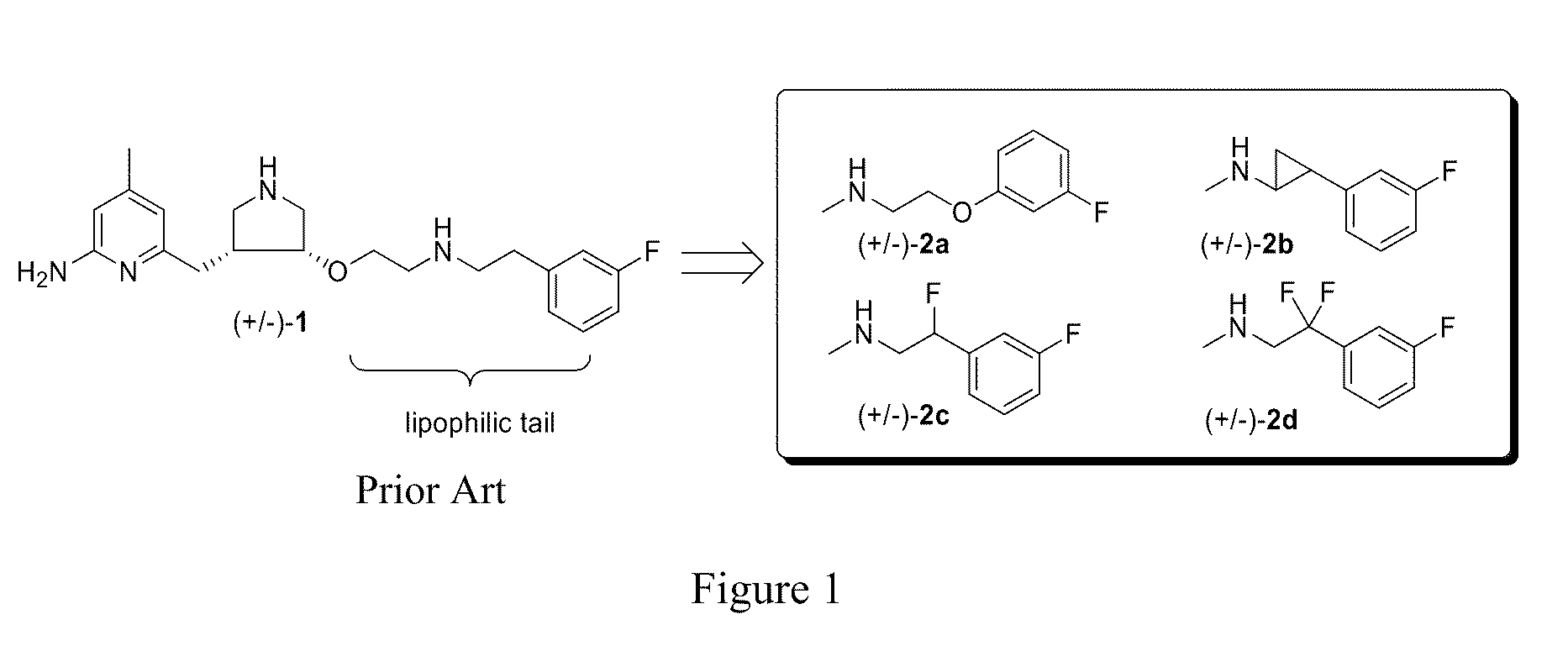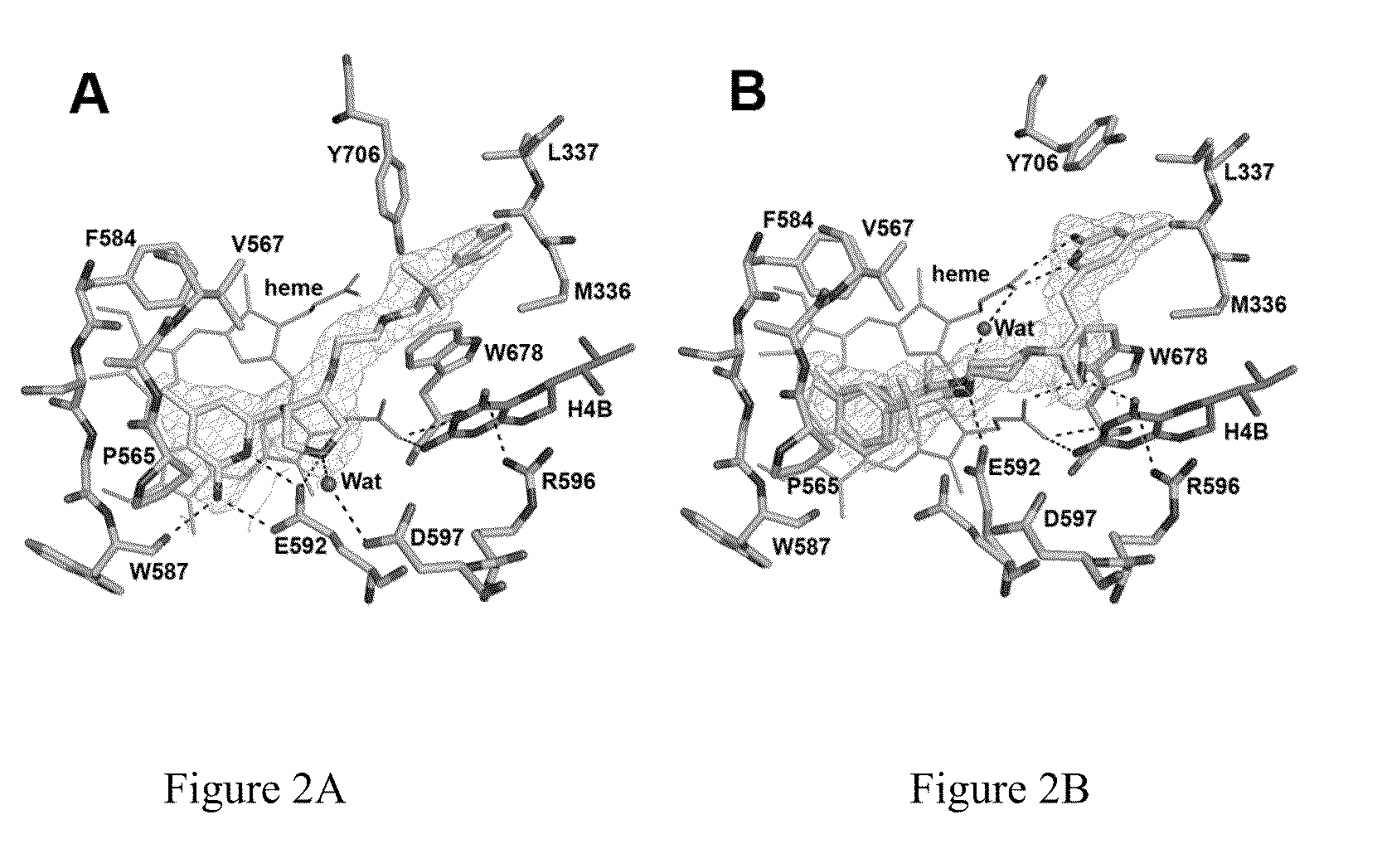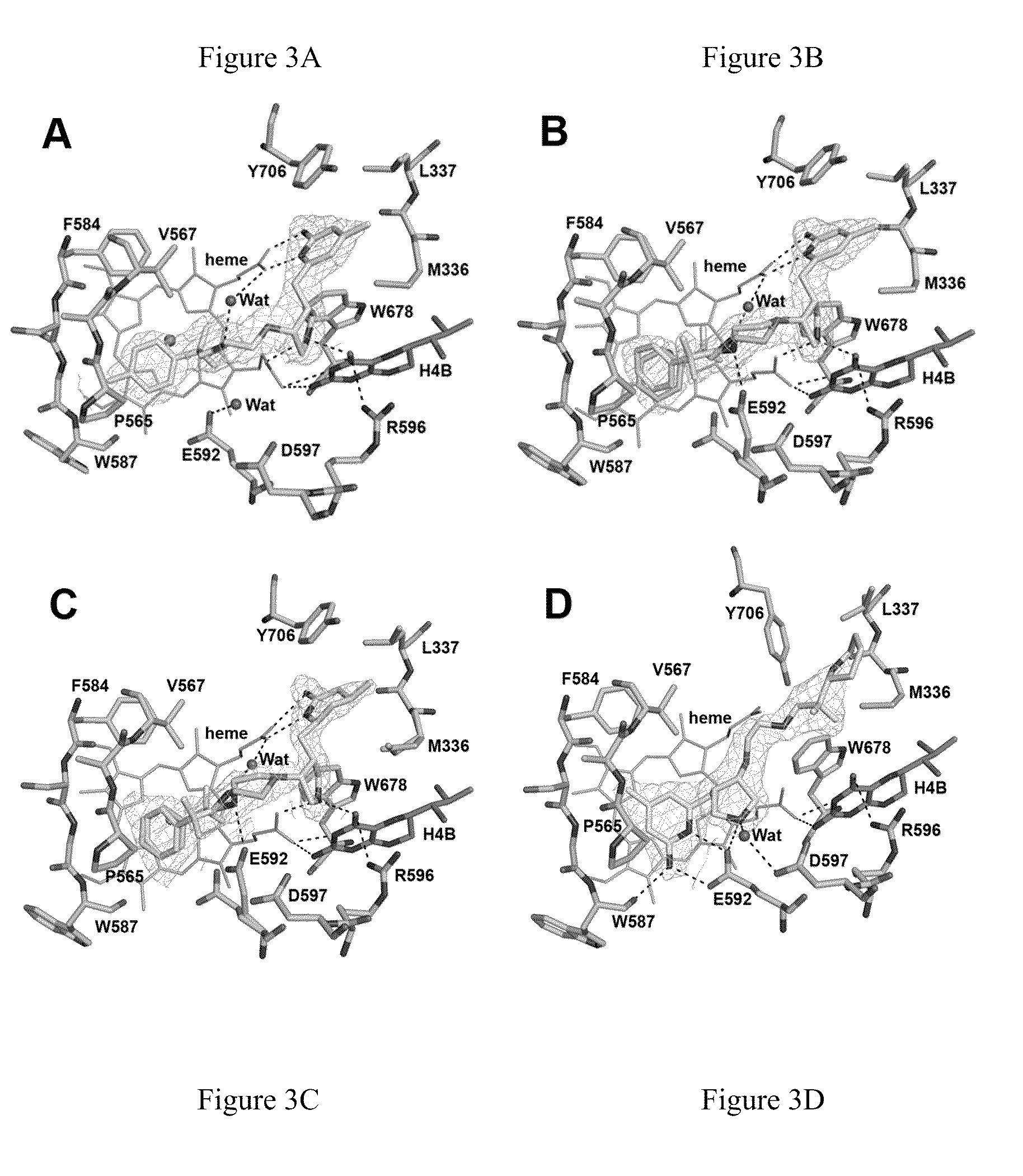Potent and selective neuronal nitric oxide synthase inhibitors with improved membrane permeability
a neuronal nitric oxide synthase and inhibitor technology, applied in the direction of biocide, drug composition, enzyme stabilisation, etc., can solve the problems of inducible nitric oxide synthase (inos), undesirable, and impede the application of neurodegenerative therapies, so as to improve the potency and selectivity, improve the membrane permeability and bioavailability, and reduce the basicity of an ethanamino nitrogen center
- Summary
- Abstract
- Description
- Claims
- Application Information
AI Technical Summary
Benefits of technology
Problems solved by technology
Method used
Image
Examples
example 1
[0069](E)-Methyl 3-(3-fluorophenyl)acrylate (6). To a solution of (E)-3-(3-fluorophenyl)acrylic acid (5, 6.0 g, 32.7 mmol) in MeOH (150 mL) at 0° C. was added concentrated H2SO4 (3.0 mL) slowly. The reaction was heated under reflux for 24 h then cooled to room temperature and neutralized with Na2CO3 (1.0 g). The solvent was removed by rotary evaporation and the resulting yellow oil partitioned between EtOAc (300 mL) and saturated NaHCO3 (300 mL). The aqueous layer was extracted with EtOAc (2×100 mL). The combined organic layers were washed with brine (200 mL) and dried over Na2SO4. The solvent was removed by rotary evaporation to yield 6 as a low melting (1H NMR (500 MHz, CDCl3) δ 3.79 (s, 3H), 6.39-6.43 (d, J=16.0 Hz, 1H), 7.04-7.07 (dt, J=2.0, 8.0 Hz, 1H), 7.18-7.20 (d, J=9.0 Hz, 1H), 7.25-7.26 (d, J=8.0 Hz, 1H), 7.30-7.35 (m, 1H), 7.60-7.64 (d, J=16.0 Hz, 1H); 13C NMR (125 MHz, CDCl3) δ 52.0, 114.4, 114.6, 117.3, 117.4, 119.4, 124.29, 124.32, 130.6, 130.7, 136.8, 136.9, 143.6, 14...
example 2
[0070]Methyl 2-(3-fluorophenyl)cyclopropanecarboxylate (7). To a solution of KOH (2.5 g, 45 mmol) in H2O (4 mL) in a Mini Diazald apparatus (Aldrich Z108898) was added dropwise 2-(2-ethoxyethoxy)ethanol (14.0 mL) and ether (8.0 mL). To the condenser of the apparatus was attached a round-bottom receiving flask (Caution: this flask must have a clear-seal joint). The receiving flask was put in a Dry Ice-acetone bath. A glass tube (Caution: this tube must have fire-polished ends) was attached to the side arm of the apparatus, which ended in an ether (˜5 mL) trap in a Dry Ice-acetone bath. A separate clear-seal-joint funnel was placed over the reaction vessel. This funnel was charged with a solution of Diazald (5.0 g, 23 mmol) in ether (30 mL). The reaction vessel was warmed slowly to 65° C. The Diazald solution was added slowly to the reaction vessel over a period of 20 min. Afterward, additional ether (10 mL) was added to the reaction vessel through the top funnel at the same temperatu...
example 3
[0072]2-(3-Fluorophenyl)cyclopropanecarboxylic acid (8). To a solution of 7 (390 mg, 2.0 mmol) in MeOH (5 mL) was added 2N NaOH (5 mL) slowly. The reaction solution was stirred at room temperature for 2 h then diluted with H2O (25 mL). After extraction with ether (20 mL), the aqueous layer was acidified with 2N HCl (2.1 mL). The resulting solution was extracted with ether (3×40 mL). The combined organic layers were dried over MgSO4 and concentrated to give 8 (325 mg, 1.8 mmol, 99%) as a light yellow oil: 1H NMR (500 MHz, CDCl3) δ 0.87-0.91 (dd, J=6.0, 13.5 Hz, 1H), 1.21-1.29 (m, 1H), 1.39-1.43 (ddd, J=5.0, 6.5, 8.0 Hz, 1H), 1.67-1.72 (m, 1H), 1.90-1.94 (m, 1H), 2.58-2.63 (m, 1H), 6.79-6.82 (dd, J=2.0, 5.5 Hz, 1H), 6.90-6.95 (m, 2H), 7.24-7.28 (m, 1H), 8.90-11.00 (br s, 1H); 13C NMR (125 MHz, CDCl3) δ 17.8, 24.4, 26.9, 31.8, 113.3, 113.5, 113.8, 114.0, 122.30, 122.32, 130.2, 130.3, 142.4, 142.5, 162.2, 164.2, 179.8; LCQ-MS (M−H+) calcd for C10H8FO2 179. found 179.
PUM
| Property | Measurement | Unit |
|---|---|---|
| pKa | aaaaa | aaaaa |
| temperature | aaaaa | aaaaa |
| temperature | aaaaa | aaaaa |
Abstract
Description
Claims
Application Information
 Login to View More
Login to View More - R&D
- Intellectual Property
- Life Sciences
- Materials
- Tech Scout
- Unparalleled Data Quality
- Higher Quality Content
- 60% Fewer Hallucinations
Browse by: Latest US Patents, China's latest patents, Technical Efficacy Thesaurus, Application Domain, Technology Topic, Popular Technical Reports.
© 2025 PatSnap. All rights reserved.Legal|Privacy policy|Modern Slavery Act Transparency Statement|Sitemap|About US| Contact US: help@patsnap.com



